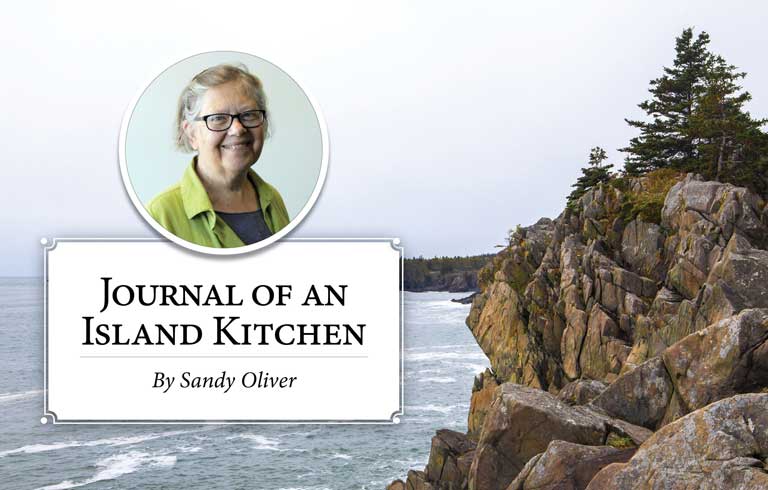Last weekend we stacked firewood in the barn, collecting and piling small pieces separately for kindling. Over the 30-plus years I’ve cooked on a wood burning kitchen stove, I’ve gotten mighty fussy about firewood, and can tell just by looking at a stick whether it will fit the kitchen stove or the living room stove. Whether it’s soft or hardwood determines when I use it and the weather often determines the menu.
Pictures of our island from the last half of the 1800s and early 1900s show wide vistas of virtually treeless land. Wood harvesting, not just on islands, but throughout all of Maine famously for the mast trade and the lumbering industry, for making fields for pasturing and growing, and warming homes here and even elsewhere, cleared the land.
Adrianna Bunker, who lived in this house before me, stored firewood in a green painted box. We found it in the dining room when we first moved in and moved it into the kitchen where it fit perfectly in the space behind the stove between the boxed-in kitchen chimney and the wood room door, and its paint color matches the wall underneath peeling wallpaper. (The Bunkers used the same paint color in the privy.) I suspect, though, that, as wood became scarce,
Recent ferry fare increases turned mainland firewood into a pricey proposition, so for now we rely on local supply.
Adrianna may have switched to coal at some point for at least one of the stoves that heated her home.
Nowadays, there are lots of trees growing here, mostly softwood perfectly OK for shoulder seasons, and the occasional oak, ash, and maple. For solid hardwood we’ve bought firewood from the mainland and cut birch, red maple, and even poplar from the property.
Unsuitable for heating, aging softwood that toppled over in many storms fills the woods here with masses of what look like pick-up sticks, is better suited as habitats for small creatures and microorganisms.
Recent ferry fare increases turned mainland firewood into a pricey proposition, so for now we rely on local supply. Several neighbors acquired pellet stoves and let a few mainland companies deliver it by the pallet. As time goes by, I may have to do that, too, or rely more on my solar panels to generate electric heat.
But you can’t really cook well on a pellet stove.
Lots of our old traditional Maine dishes assumed long, slow cooking. Baked beans, stewy soupy dishes, steamed puddings, and brown bread, which bubbled in hot water for a couple of hours, are not preferred activities conducted on metered or tanked energy.
When the temperature outside declines enough that a continuous woodstove fire is more than welcome, out come the chili, soup, and stew cookpots. It’s a good time to make more than we’ll eat in a couple days. At that point, glass peanut butter or canning jars full of deliberate excess becomes homemade fast-food stashed in the freezer for milder weather.
Otherwise, anything else fries, simmers, stews on the hot surface. A kettle of water humming on the back of the stove means a hot cup of tea on demand. Enough variations in temperature over the surface means that you can bring your oatmeal or rice to a boil, then shove it over to simmer along until done.
Lift one of the stove lids, and hot coals are perfect for grilling. I set a wok in the opening for stir fries. Of course, one can do this on a gas grill, too, but when it is very cold, I prefer being inside.
In fact, when the forecast predicts very low temperatures for a couple of days, I soak beans to bake a pot full. My elderly stove no longer climbs to the heat needed for baking pie or a pan of biscuits. It will, however, maintain 200 to 250 when the stove is roaring along, sufficient to cook beans tucked into the back corner nearest the firebox.
I love the stove as a place to dry freshly washed pots and pans. Set a big old cook pot, soaking wet on the surface with a great rattle and hiss of steam and seconds later, I can put it away.
Evidence of cooking on wood and heating the house with it for three decades finally showed up in my body. Try as I might to switch off, I usually carry wood in my left arm and fill it with my right hand. As a result, my left shoulder is higher than my right, and so some of my clothes pucker oddly in the front.
You know what? I don’t care. I like cooking on wood.
Sandy Oliver is a food historian who gardens, cooks, and writes on Islesboro. She may be contacted at SandyOliver47@gmail.com.





